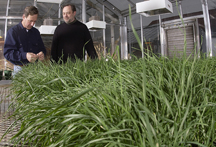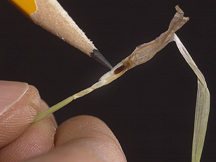
| RELATED INFO |
| * Purdue Department of Entomology |
| * Purdue Entomology Molecular Biology and Genetics |
| * USDA-Agricultural Research Service |

March 7, 2007
Scientists find genes involved in the battle between Hessian flies and wheat
WEST LAFAYETTE, Ind. - |
Purdue University and USDA-Agriculture Research Service scientists trying to thwart the insect have identified Hessian fly genes that nullify toxins that wheat produces to protect itself from the munching larvae. The researchers report their findings in the Feb. 6 issue of the journal Proceedings of the National Academy of Sciences.
Richard Shukle, a USDA-ARS entomologist and Purdue adjunct assistant professor, is working with colleagues to learn more about how the flies feed and why they can't establish a feeding site on plants that are resistant to the larvae.
"The focus of our work is to try to understand how the insect overcomes plant resistance and use that basic knowledge to enhance the durability of wheat against Hessian fly attack by combining several genes for resistance or through some other novel strategies," said Shukle, senior and corresponding author of the paper.
The toxic oxygen compound defense mechanism in resistant plants stresses the larvae, which then fight back, he said. This is confirmed by the Hessian fly larvae's increased production of enzymes triggered by their antioxidant genes in order to detoxify wheat anti-insect poisons.
"Hessian fly larvae are under stress when they encounter resistant wheat plants," Shukle said. "This stress includes starvation when they can't establish a feeding site. The larvae also are under stress from toxic molecules, including poisonous oxygen compounds."
 |
Researchers know little about the biochemical mechanisms involved when larvae - the early stages of the gnat-sized Hessian fly - try to feed on resistant wheat plants that are able to defend themselves, Shukle said. While the insects can't establish feeding sites on resistant plants, the larvae can alter the physiology and change the level of certain proteins in susceptible plants. This forces the plant to feed the larvae.
On resistant plants, Hessian fly larvae encounter defense mechanisms that include poisonous oxygen compounds, Shukle said. These compounds, also called reactive oxygen species, can be produced either by the plant or within the Hessian fly larval digestive system. These poisons then disrupt the insects' gut function.
"The larvae probe the plant to open a sustained feeding site," said Jonathan Neal, a Purdue entomologist and another author of the paper. "Resistant plants block the larvae from establishing a feeding site. It's as if larvae keep trying to open doors because they are programmed to look for a feeding site.
"In resistant plants, the doors are all locked. Then the larvae finally crawl down to the base of the plant and die. This is death by frustration."
Hessian flies can be controlled by using specifically bred wheat varieties called resistant wheat cultivars. Infestations by the flies also can be prevented by planting wheat after the fly is no longer active and laying eggs. This "fly-free date" is set in different regions according to climate.
The study represents a step in understanding the complexity of antioxidant defense responses during interaction between Hessian flies and wheat, he said. It may also be applicable to other insect-plant interactions.
Hessian flies have been in the United States for more than 200 years, apparently accidentally introduced by German mercenaries during the Revolutionary War.
The flies are found worldwide, but the U.S. infestation has been mainly in the Southeast. In Georgia during the 1980s, wheat crop losses totaled $28 million in one year when the insect overcame the plant's resistant gene that was being used at the time.
Over the past two years, the pest also has caused extensive yield losses in southeastern Missouri and a resurgence occurred in Oklahoma in 2006. Most recently, a Hessian fly infestation was identified near Lafayette, Ind., where the insect hadn't been reported for more than a decade.
Purdue University, USDA-ARS and the USDA Current Research Information System provided support for this project
The study's lead author was Omprakash Mittapalli, a former graduate student in Shukle's laboratory. Mittapalli is now a postdoctoral fellow at the Max Planck Institute for Chemical Ecology in Jena, Germany.
Writer: Susan A. Steeves, (765) 496-7481, ssteeves@purdue.edu
Sources: Richard Shukle, (765) 494-6351, shukle@purdue.edu
Jonathan Neal, (765) 494-4954, jneal@purdue.edu
Ag Communications: (765) 494-2722;
Beth Forbes, forbes@purdue.edu
Agriculture News Page
PHOTO CAPTION:
Purdue researchers, from left, Richard Shukle and Jonathan Neal examine plots of wheat infested with Hessian fly larvae. Their research has identified genes in the insects that produce enzymes in response to toxins plants use to protect themselves from the flies. (Purdue Agricultural Communication photo/Tom Campbell)
A publication-quality photo is available at https://www.purdue.edu/uns/images/+2007/shukle-wheat.jpg
PHOTO CAPTION:
No larger than a pencil point, this shaft of wheat grown in a Purdue greenhouse is infested with Hessian fly larvae. The darker puparium is an advanced stage, from which an adult fly will emerge. (Purdue Agricultural Communication photo/Tom Campbell)
A publication-quality photo is available at https://www.purdue.edu/uns/images/+2007/shukle-hessionfly.jpg
Antioxidant Defense Response in a Galling Insect
Herbivorous insect species are constantly challenged with reactive oxygen species (ROS) generated from endogenous and exogenous sources. ROS produced within insects because of stress and prooxidant allelochemicals produced by host plants in response to herbivory require a complex mode of antioxidant defense during insect/plant interactions. Some insect herbivores have a midgut-based defense against the suite of ROS encountered. Because the Hessian fly (Mayetiola destructor) is the major insect pest of wheat worldwide, and an emerging model for all gall midges, we investigated its antioxidant responses during interaction with its host plant. Quantitative data for two phospholipid glutathione peroxidases (MdesPHGPX-1 and MdesPHGPX-2), two catalases (MdesCAT-1 and MdesCAT-2), and two superoxide dismutases (MdesSOD-1 and MdesSOD-2) revealed high levels of all of the mRNAs in the midgut of larvae on susceptible wheat (compatible interaction). During development of the Hessian fly on susceptible wheat, a differential expression pattern was observed for all six genes. Analysis of larvae on resistant wheat (incompatible interaction) compared with larvae on susceptible wheat showed increased levels of mRNAs in larvae on resistant wheat for all of the antioxidant genes except MdesSOD-1 and MdesSOD-2. We postulate that the increased mRNA levels of MdesPHGPX-1, MdesPHGPX-2, MdesCAT-1, and MdesCAT-2 reflect responses to ROS encountered by larvae while feeding on resistant wheat seedlings and/or ROS generated endogenously in larvae because of stress/starvation. These results provide an opportunity to understand the cooperative antioxidant defense responses in the Hessian fly/wheat interaction and may be applicable to other insect/plant interactions.
To the News Service home page
If you have trouble accessing this page because of a disability, please contact Purdue News Service at purduenews@purdue.edu.
